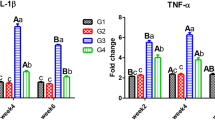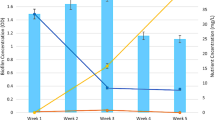Abstract
Microcystis growth and physiological responses to chloramphenicol (CAP)-stress were explored at different phosphorus (P) concentrations during 20-day exposure. Under CAP-stress, Microcystis exhibited (i) stronger total protein synthesis and antioxidant defenses at 5 mg/L P than 0.05–0.5 mg/L P in early test period (before day 8), and (ii) greater CAP-removal via biodegradation at 5 mg/L P in mid-late period. Due to above mechanisms, 5 mg/L P largely alleviated the inhibitory effect of CAP on Microcystis growth until test end, thus minimizing CAP toxicity to Microcystis, compared with 0.05–0.5 mg/L P. Moreover, microcystin-production and -release by Microcystis under CAP-stress were also P-dependent. These results suggested that under CAP-stress, although Microcystis growth was more inhibited at 0.05–0.5 mg/L P, higher microcystin-release and CAP residual at 0.05–0.5 mg/L P than at 5 mg/L P still caused eco-risks, which had important implication for risk assessment during Microcystis-dominated blooms and CAP pollution co-occurrence in different waters.




Similar content being viewed by others
References
Belchik SM, Xun L (2011) S-glutathionyl-(chloro)hydroquinone reductases: a new class of glutathione transferases functioning as oxidoreductases. Drug Metab Rev 43:307–316
Bradford MA (1976) A rapid and sensitive method for the quantification of microgram quantities of protein utilizing the principle of protein-dye binding. Anal Biochem 72:248–254
Briand E, Yéprémian C, Humbert JF, Quiblier C (2008) Competition between microcystin- and non-microcystin-producing Planktothrix agardhii (cyanobacteria) strains under different environmental conditions. Environ Microbiol 10:3337–3348
Campos A, Vasconcelos V (2010) Molecular mechanisms of microcystin toxicity in animal cells. Int J Mol Sci 11:268–287
Cano-Europa E, Ortiz-ButrÓn R, Gallardo-Casas CA, Blas-Valdivia V, Pineda-Reynoso M, Olvera-Ramírez R, Franco-Colin M (2010) Phycobiliprotein from Pseudanabaena tenuis rich in c-phycoerythrin protect against HgCl2-caused oxidative stress and cellular damage in the kidney. J Appl Phycol 22:495–501
Ding Y, Gan NQ, Zheng LL, Song LR (2013) Microcystin-LR increases the fitness of Microcystis aeruginosa under H2O2 stress. Acta Hydrobiol Sin 37:515–521 (in Chinese)
Draper HH, Hadley M (1990) A review of recent studies on the metabolism of exogenous and endogenous malondialdehyde. Xenobiotica 20:901–907
EFSA CONTAM Panel (EFSA Panel on Contaminants in the Food Chain) (2014) Scientific opinion on chloramphenicol in food and feed. EFSA J 12:3907
Kong QX, Zhu LZ, Shen XY (2010) The toxicity of naphthalene to marine Chlorella vulgaris under different nutrient conditions. J Hazard Mater 178:282–286
Kümmerer K (2009) Antibiotics in the aquatic environment—a review—part I. Chemosphere 75:417–434
Li JM, Shimizu K, Zhou YL, Utsumi M, Sakharkar MK, Zhang ZY, Sun HW, Sugiura N (2011) Biodegradation of microcystins by bacterial communities co-existing with the flagellate Monas guttula and concurrent succession of community structures. J Water Suppl Res Technol AQUA 60:352–363
Li JM, Li J, Shi G, Mei ZL, Wang RP, Li DY (2016) Discerning biodegradation and adsorption of microcystin-LR in a shallow semi-enclosed bay and bacterial community shifts in response to associated process. Ecotoxicol Environ Saf 132:123–131
Li JM, Li RH, Li J (2017) Current research scenario for microcystins biodegradation—a review on fundamental knowledge, application prospects and challenges. Sci Total Environ 595:615–632
Liu H, Zhang GP, Liu CQ, Li L, Xiang M (2009) Characteristics of chloramphenicol and tetracyclines in municipal sewage and Nanming River of Guiyang City, China. Environ Sci 30:687–692 (in Chinese)
Liu Y, Chen S, Chen X, Zhang J, Gao BY (2015a) Interactions between Microcystis aeruginosa and co-existing amoxicillin contaminant at different phosphorus levels. J Hazard Mater 297:83–91
Liu Y, Chen S, Zhang J, Gao BY (2015b) Nitrogen-regulated interactions between Microcystis aeruginosa and spiramycin contaminant. Water Air Soil Pollut 226:135
Liu Y, Chen X, Zhang J, Gao BY (2015c) Hormesis effects of amoxicillin on growth and cellular biosynthesis of Microcystis aeruginosa at different nitrogen levels. Microb Ecol 69:608–617
Liu Y, Wang F, Xiao C, Zhang J, Gao BY (2015d) Cellular responses and biodegradation of amoxicillin in Microcystis aeruginosa at different nitrogen levels. Ecotoxicol Environ Saf 111:138–145
Nie MH, Yan CX, Li M, Wang XN, Bi WL, Dong WB (2015) Degradation of chloramphenicol by persulfate activated by Fe2+ and zerovalent iron. Chem Eng J 279:507–515
Polyak Y, Zaytseva T, Medvedeva N (2013) Response of toxic cyanobacterium Microcystis aeruginosa to environmental pollution. Water Air Soil Pollut 224:1494
Thompson PA, Waite AM, McMahon K (2003) Dynamics of a cyanobacterial bloom in a hypereutrophic, stratified weir pool. Mar Freshw Res 54:27–37
Vézie C, Rapala J, Vaitomaa J, Seisonen J, Sivonen K (2002) Effect of nitrogen and phosphorus on growth of toxic and nontoxic Microcystis strains and on intracellular microcystin concentrations. Microb Ecol 43:443
Wang YJ, Li YW, Luo XY, Ren YA, Gao EG, Gao HJ (2018) Effects of yttrium and phosphorus on growth and physiological characteristics of Microcystis aeruginosa. J Rare Earth 36:781–788
Watanabe MM, Kaya K, Takamura N (1992) Fate of the toxic cyclic heptapeptides, the microcystins, from blooms of Microcystis (cyanobacteria) in a hypertrophic lake. J Phycol 28:761–767
Xu DM, Li CD, Chen H, Shao B (2013) Cellular response of freshwater green algae to perfluorooctanoic acid toxicity. Ecotoxicol Environ Saf 88:103–107
Zhang SH, Xu PY, Chang JJ (2016) Physiological responses of Aphanizomenon flos-aquae under the stress of Sagittaria sagittifolia extract. Bull Environ Contam Toxicol 97:870–875
Zurawell RW, Chen H, Burke JM, Prepas EE (2005) Hepatotoxic cyanobacteria: a review of the biological importance of microcystins in freshwater environments. J Toxicol Environ Health B 8:1–37
Acknowledgements
This work was funded by the Research Fund for the Doctoral Program of Higher Education of China (Grant No. 20130008120026).
Author information
Authors and Affiliations
Corresponding author
Rights and permissions
About this article
Cite this article
Luo, L., Li, J., Zhang, Z. et al. Phosphorus Influences the Interaction Between Toxigenic Microcystis and Chloramphenicol. Bull Environ Contam Toxicol 102, 391–398 (2019). https://doi.org/10.1007/s00128-018-2505-3
Received:
Accepted:
Published:
Issue Date:
DOI: https://doi.org/10.1007/s00128-018-2505-3




